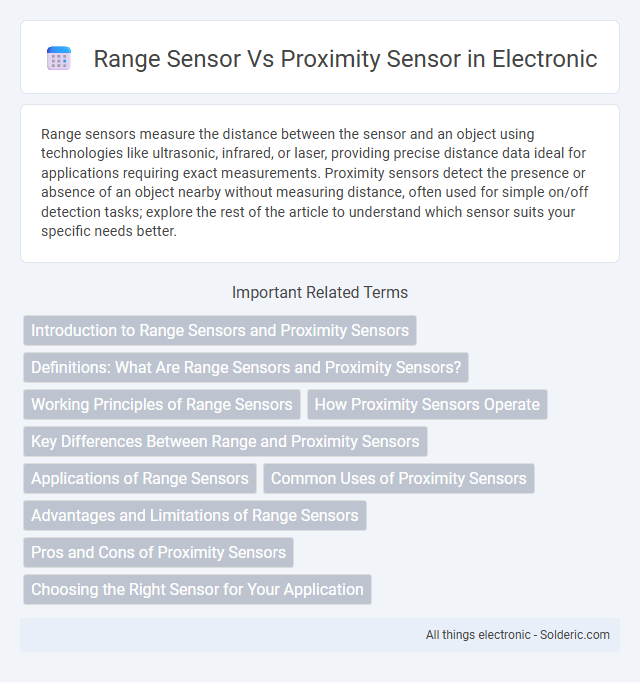Range sensors measure the distance between the sensor and an object using technologies like ultrasonic, infrared, or laser, providing precise distance data ideal for applications requiring exact measurements. Proximity sensors detect the presence or absence of an object nearby without measuring distance, often used for simple on/off detection tasks; explore the rest of the article to understand which sensor suits your specific needs better.
Comparison Table
| Feature | Range Sensor | Proximity Sensor |
|---|---|---|
| Function | Measures the distance to an object | Detects presence or absence of an object near the sensor |
| Measurement | Distance (in meters, centimeters) | Binary detection (object present or not) |
| Working Principle | Uses ultrasonic, infrared, laser, or radar waves | Uses capacitive, inductive, ultrasonic, or infrared sensing |
| Detection Range | Longer distances (up to several meters) | Short distances (usually less than 10 cm) |
| Output | Analog or digital distance value | Digital ON/OFF signal |
| Applications | Robotics, obstacle detection, distance measurement | Object detection, proximity triggering, safety systems |
| Accuracy | High accuracy for distance measurement | Less precise, only presence detection |
Introduction to Range Sensors and Proximity Sensors
Range sensors measure the exact distance between the sensor and an object by using technologies such as ultrasonic, infrared, or laser, providing accurate spatial data essential for applications like robotics and automation. Proximity sensors detect the presence or absence of objects within a certain range without measuring the exact distance, commonly utilizing capacitive, inductive, or photoelectric methods for object detection and collision avoidance. Understanding the difference between these sensors helps you select the right technology for tasks requiring precise measurement versus simple object detection.
Definitions: What Are Range Sensors and Proximity Sensors?
Range sensors measure the distance between the sensor and an object by emitting signals such as ultrasonic waves, infrared light, or laser beams and calculating the time it takes for the signals to return. Proximity sensors detect the presence or absence of objects within a specific range without providing precise distance measurements, often using electromagnetic fields, capacitive sensing, or inductive detection methods. Understanding the difference helps you select the right sensor for applications requiring either detailed distance data or simple object detection.
Working Principles of Range Sensors
Range sensors operate by emitting signals such as ultrasonic waves, laser light, or infrared beams and measuring the time or phase shift taken for the signals to reflect back from an object. These sensors calculate the distance to the object based on the time-of-flight or triangulation methods, providing precise spatial information. Your choice of range sensor depends on accuracy requirements, environmental conditions, and the target object's material properties.
How Proximity Sensors Operate
Proximity sensors operate by detecting the presence or absence of an object within a specific range without physical contact, using methods such as capacitive, inductive, ultrasonic, or infrared technology. Inductive proximity sensors generate an electromagnetic field to detect metal objects, while capacitive sensors respond to changes in the dielectric constant caused by any material. Ultrasonic sensors emit sound waves and measure the time it takes for the echo to return, enabling accurate object detection and distance measurement.
Key Differences Between Range and Proximity Sensors
Range sensors measure the distance to an object by emitting signals such as ultrasonic waves, infrared, or lasers and calculating the time it takes for the reflections to return, providing precise distance data. Proximity sensors detect the presence or absence of an object within a predefined range without providing exact distance measurements, commonly using capacitive, inductive, or optical technologies. The key difference lies in range sensors offering detailed distance information, while proximity sensors only indicate object presence or absence within their detection zone.
Applications of Range Sensors
Range sensors are widely used in applications such as autonomous vehicles for obstacle detection and navigation, robotics for environment mapping, and industrial automation to ensure precise distance measurement for safety and quality control. These sensors enable drones to maintain altitude and avoid collisions, while in healthcare, they assist in patient monitoring through non-contact distance assessment. Their ability to provide accurate spatial data makes them essential in smart home systems for gesture recognition and presence detection.
Common Uses of Proximity Sensors
Proximity sensors are commonly used in industrial automation for object detection, conveyor belt monitoring, and safety system activation. They are integral in smartphones for screen activation by detecting the presence of the user's face. Automotive applications also rely on proximity sensors for parking assistance and collision avoidance systems.
Advantages and Limitations of Range Sensors
Range sensors offer precise distance measurements, enabling accurate object detection and spatial awareness in applications such as robotics and automation. Their advantages include high resolution and the ability to detect objects at varying distances, but they are often limited by environmental factors like lighting conditions and surface reflectivity. You should consider these limitations when selecting range sensors for tasks requiring consistent performance in diverse settings.
Pros and Cons of Proximity Sensors
Proximity sensors offer advantages such as non-contact detection, durability in harsh environments, and cost-effectiveness for short-range object detection. Their limitations include limited sensing distance, susceptibility to interference from nearby metals or electromagnetic fields, and lower accuracy compared to range sensors in measuring exact distances. These sensors are ideal for simple presence detection but may struggle in applications requiring precise spatial measurements.
Choosing the Right Sensor for Your Application
Selecting the right sensor depends on the specific requirements of your application, with range sensors offering precise distance measurements ideal for object detection and navigation. Proximity sensors excel at detecting the presence or absence of nearby objects without measuring exact distance, making them suitable for simple on/off detection tasks. Understanding factors like detection range, sensing technology, response time, and environmental conditions ensures optimal sensor performance and accuracy.
Range sensor vs proximity sensor Infographic

 solderic.com
solderic.com